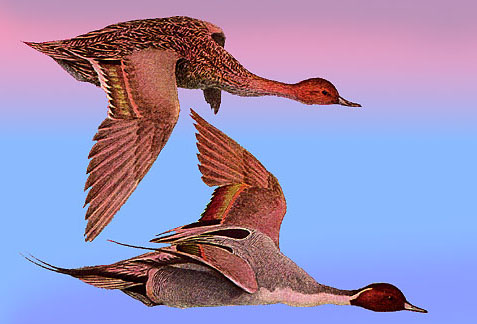 Northern
Pintail Northern
Pintail
GENERAL DESCRIPTION:
Length, 24 to 30 inches. Males are gray above and whitish below; females are brown, varied
on body with ocher and dusky. Both sexes have the head small and not crested, the neck
long, and the tail long and pointed with I6 feathers; in the male the two central
tall-feathers are from s to 9 inches in length. Color. |
OTHER NAMES:
MALE: Sprig-tail; Split-tail; Spiketail; Picket-tail; Peak-tail; Sharp-tail; Sprit-tail;
Spring-tail; Spindle-tail; Rite-tail; Pigeon-tail; Pheasant-dock; Sea-pheasant. FEMALE:
Gray Duck; Pied Gray Duck; Pied Widgeon. EITHER SEX: Winter Duck; Lady-bird; Long-necked
Cracker;Harlan; Smee. |
ADULT MALE:
Head and neck above, dark brown glossed with green and purple; back of neck with a stripe
shading into the gray color of back; back, finely waved with dusky and white;
shoulder-feathers and long inner secondaries, striped lengthwise with velvety-black and
silvery-gray; lesser wing-coverts, plain gray; greater coverts, tipped with rufous or
cinnamon, edging front of speculum; speculum, greenish in front, bronzy with violet
reflections behind where edged with the white tips of secondaries; two long central
tail-feathers, black; the remaining fourteen tail-feathers, gray; throat, white running up
behind back of head in a narrow stripe; breast, abdomen and sides, whitish, finely waved
with black on sides; under tail-coverts, black; bill and feet, grayish-blue; iris, brown. |
ADULT FEMALE:
Head and neck all around, warm yellowish-brown with indistinct streaking; rest of plumage,
varied with ocher, plain brown, and dusky; tail without long central feathers; wing, as in
male but much smaller; bill, dusky bluish; feet, dull grayish-blue; iris, brown. |
NEST:
On the ground, usually in tall bunches of prairie grass, near water; made of dry grass,
snugly and warmly lined with down. |
EGGS:
7 to 10, pale greenish to olive-buff. |
|
 Distribution: Distribution:
Northern hemisphere; in North America breeds on Arctic coast from Alaska to Keewatin and
south to southern California, southern Colorado, northern Nebraska, northern Iowa, and
northern Illinois; winters from southern British Columbia, Nevada, Arizona, southern
Missouri; southern Wisconsin, southern Ohio, Pennsylvania (rarely), and Delaware south to
Puerto Rico and Panama, and in Hawaii; in migration occasional on the Atlantic coast to
northern Ungava, Greenland, and Newfoundland, and in Bermuda. |
The Pintail can be characterized as the greyhound among waterfoul. It is an
interesting, agile, swift-flying, hardy species, the male being wonderfully garbed in a
most effective blending of gray, white, and brown, surpassing many other birds of more
gaudy hues.
Though shy enough ordinarily, it becomes readily accustomed to man. The young are easy
to rear and grow up very tame.
Though Pintails breed in the northerly parts of the continent, they also do so in our
northwestern States. They are hardy and early, arriving in spring often before all the ice
is out of the lakes. In northern Manitoba fully fledged young can be seen as early as June
25th, their primaries not quite long enough for flight. Such eggs are laid in late March
or April when conditions there are decidedly wintry. The nest is usually in dry grass or
in a clump of weeds. Small dry islands are favorite locations. Otherwise nests seem to be
placed quite regardless of proximity to water.
Nests are frequently found far back on the dry prairie, a mile from the nearest slough.
It is perhaps more flimsily built than with most other Ducks, and often has rather less
down than the average. The number of eggs in a clutch run slightly less than with other
species, seven or eight being most common, and seldom over nine or ten.
In migration it is not at all common in eastern waters, but in the Mississippi valley and
west it is probably next to the Mallard in abundance.
It prefers shallow ponds and marshy areas where grass and sedge grow from the water. In
the sloughs where it breeds, the mated pairs swimming about make a beautiful sight. Even
in autumn when the male has lost for the time his distinctive plumage, the birds are quite
distinct, owing to their slender forms and long necks, and their movements always have the
air of grace and good breeding.
| Duck-like Birds | Home
| Bird Classifications | |
 Northern
Pintail
Northern
Pintail
 Distribution:
Distribution: